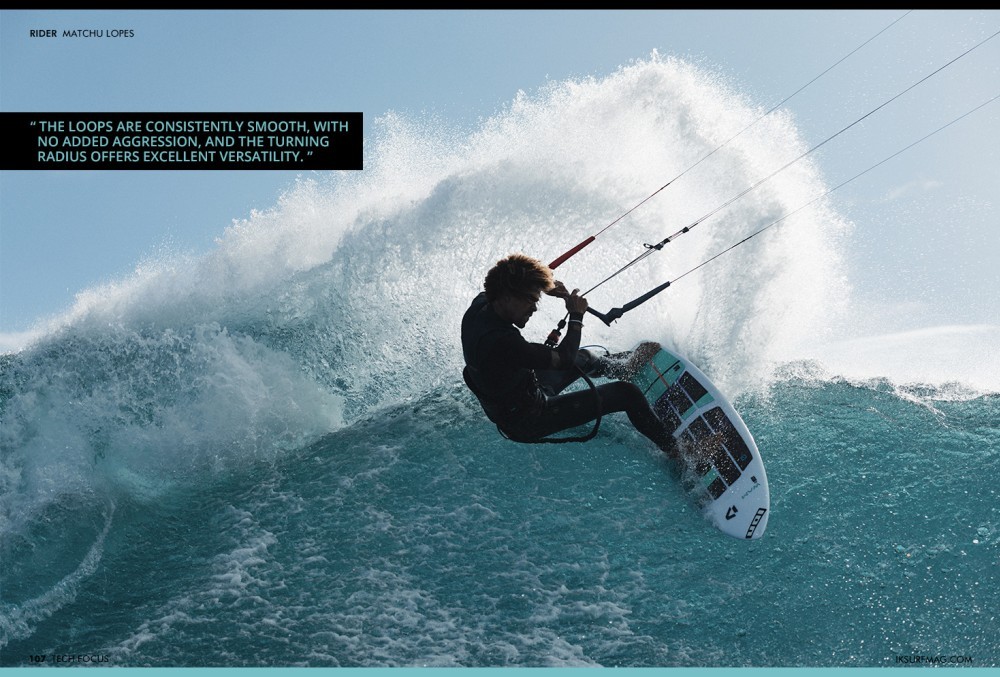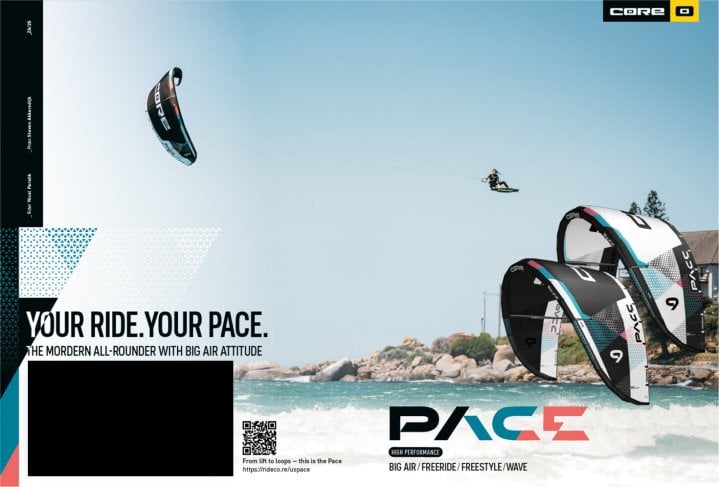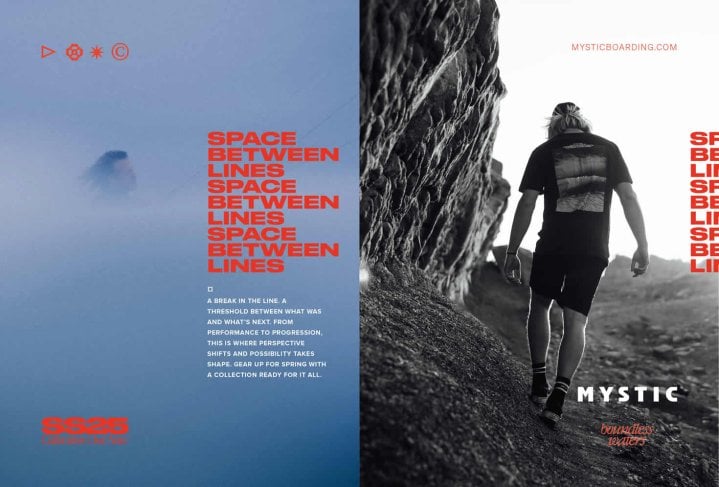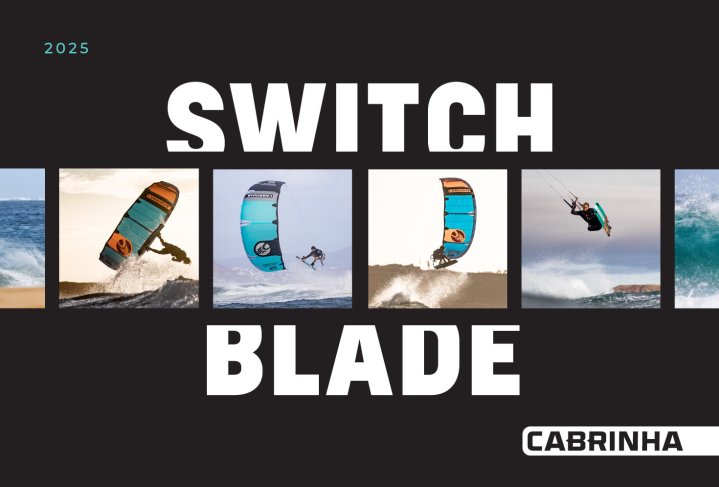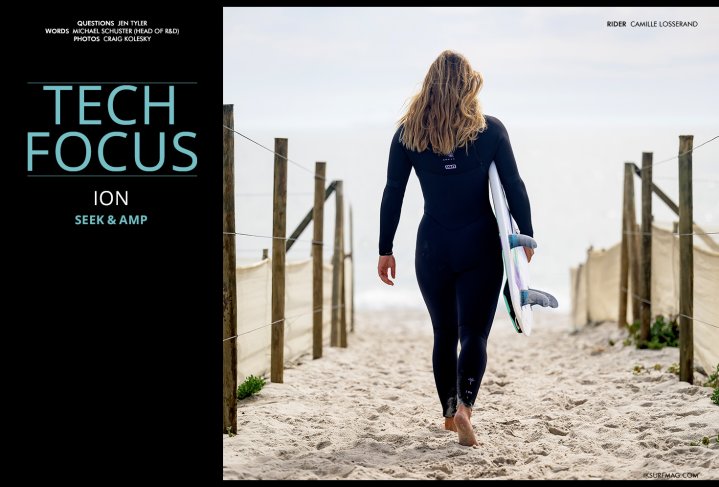
Tech Focus - ION Seek & Amp
Issue 107 / Fri 11th Oct, 2024
In this Tech Focus, we dive into the latest in wetsuit innovation with ION’s new Seek & Amaze Amp range! Jen Tyler chats with Michael Schuster, Head of R&D at ION, to explore how Max_Flex Technology is pushing the boundaries of flexibility, warmth, and performance. From a 30% increase in the stretch to eco-conscious materials, find out more about ION’s wetsuit design.
Hi! We're super excited to hear about the latest advancements in ION's new Seek & Amaze Amp Wetsuit Range. For starters, please talk to us through Max_Flex Technology. The Seek and AmazeAmp already have a reputation for being the stretchiest wetsuits on the market, but how did you achieve a 30% increase in stretch, and what materials and structural changes did you make?
Max_Flex is the name of the outer lining. Wetsuits typically have three layers: the inner lining, the rubber core, and the outer lining. All three layers contribute to a wetsuit’s flexibility. However, the outer lining significantly impacts stretch, assuming all other factors remain constant.
With performance in mind, we focused heavily on developing Max_Flex. It offers up to 30% more stretch with the same amount of force.
The key to Max_Flex's superior flexibility lies in its unique knitting technique. The fabric is woven in a rhombus-shaped pattern, with the long axes aligned horizontally and vertically. This structure allows for greater elasticity compared to square or rectangular weaves. Small channels between the rhombus shape also increase flexibility and assist with water drainage.
Does the 30% increase in stretching impact the wetsuit’s longevity and durability?
We rigorously tested the materials and wetsuits while developing the new AMP line. Striking the right balance between durability and flexibility is always a challenge, but we achieved the ideal combination through extensive lab and field testing. The AMP wetsuits are as long-lasting as our regular models, but durability largely depends on the seams. For this reason, the AMP line features fully taped seams on the inside and reinforced cuffs for added strength.
However, proper care is the most crucial factor for extending a wetsuit’s lifespan. To maintain your wetsuit, rinse it after every use, handle it carefully when putting it on and taking it off, avoid drying it in direct sunlight, and refrain from using hangers that can damage the shoulder area. Following these simple tips can significantly enhance its longevity.
How important is it to rinse your suit, and what should we all do to care for our wetsuits?
Rinsing your wetsuit enhances its durability, especially during periods of non-use. Rinse it with fresh water to remove sand, sweat, and salt. If needed, use a mild biodegradable detergent, but keep detergent to a minimum to preserve the neoprene's plasticisers, which maintain its stretch. Be sure to thoroughly rinse out all detergent afterwards.
How does the wetsuit’s flexibility impact power transfer and energy efficiency during kite sessions, for example, board grabs or rotations?
This is where Max_Flex truly shines. Freedom of movement is essential, especially in the arms and shoulders, which is why Max_Flex is strategically placed in the upper torso areas.
For instance, think about grabs—or even passes or any movement that involves twisting your upper body. With Max_Flex, you require less effort to achieve the same stretch. This means that reaching the nose of your board, for example, will take less energy. Suddenly, those extra centimeters you couldn’t reach before are now within grasp.
Less effort also means more endurance. You’ll have more attempts, more practice, and likely master your tricks sooner.
With Max_Flex in our Seek and Amaze AMP wetsuits, it almost feels like you’re wearing a thinner suit than you actually are.
The Seek and Amp are now fully taped; how does that enhance heat retention compared to regular seam construction, and what advantages does it give in reducing water entry? Are there any downsides in terms of flexibility?
Unlike stitched seams, taped seams prevent water from entering the wetsuit. Over time, water will inevitably seep through traditional seams, leading to a noticeable drop in heat retention. Taped seams might reduce freedom of movement, but the impact is minimal.
The real advantage is warmth: taped seams allow you to choose a thinner wetsuit without sacrificing insulation. A thinner suit means more freedom of movement, as having even one less millimeter of neoprene on your body can make a big difference in flexibility.
What are the environmental benefits of using oyster shell powder and limestone in the neoprene?
These alternative resources replace petroleum in wetsuit production. Traditionally, neoprene was made from petroleum, which is extracted from deep underground and requires a significant amount of energy, leading to considerable air pollution. Today, more sustainable options like oyster shell powder and limestone are used, which have a much smaller environmental footprint.
While the production of neoprene still consumes energy, it’s far less than when petroleum is involved. However, it’s important to acknowledge that even with these advancements, wetsuits remain net negative for the environment. That’s why our R&D is focused on reducing the product’s impact in meaningful ways.
That said, it’s essential to recognise that every wetsuit, and indeed every product we buy, affects the environment—regardless of the materials or production methods used.
What are the challenges in creating a wetsuit that balances high performance with sustainable materials?
Incorporating environmentally friendly materials into wetsuits must make sense for the user in all aspects. Sustainability alone isn’t enough if it compromises performance. That's why we were excited to find a way to source Max_Flex from recycled nylon waste—it was a balance between eco-friendliness and performance.
Achieving this balance, however, is challenging. First, it’s no secret that sustainable fabrics often increase costs. If the final product is priced too high, its eco-friendly materials won’t have much impact. Second, many sustainable alternatives still fall short in terms of flexibility and durability, leaving significant room for innovation.
Looking ahead, we’re confident that future wetsuits will strike an even better balance between performance and sustainability. In the meantime, we believe the most sustainable approach is to maximize a product’s lifespan and improve recyclability.
The one-hand zipper is a great addition. Under repeated use, what is the zipper's expected durability and push-button locking system?
ION: The zipper’s durability is comparable to standard options. We use a state-of-the-art YKK zipper, and to ensure longevity, we've reinforced the end to prevent damage from excessive force when opening the suit.
How does the 3D mesh channel system reduce drying time compared to traditional wetsuits?
We incorporated small channels between the rhombus-shaped structure of our Max_Flex lining. These channels help drain water more quickly from the wetsuit, enhancing both comfort and performance.
How does the Seek & Amaze Amp line compare to other wetsuits on the market in terms of sustainability, flexibility, warmth, and overall value?
We’re thrilled to have enhanced the Amp line in various aspects while also lowering consumer prices slightly. The Amp suits are performing exceptionally well, often outpacing many larger brands, as evidenced by numerous magazine tests and awards. When compared, Amp suits are priced alongside other brands' top-line wetsuits. As a European brand, it makes us proud to compete with major Australian and US brands, motivating us to push even further. Given that the Amp is ION’s second most premium suit, we are confident in showcasing our technological leadership with the Select level wetsuits.
These days, a wetsuit is quite a big investment for people; what has pushed production costs up over the years?
The main reason for rising production costs since COVID-19 is that everything has become more expensive. Shipping costs doubled in just one year, raw material prices surged due to increased demand, and inflation has also significantly impacted costs. During the wetsuit development process, we scrutinized every detail—from the wetsuit design to production and material sourcing. This allowed us to identify key cost drivers, enabling us to enhance the new AMP level while keeping prices low.
What's the most essential factor for someone choosing a suit?
First, we want to acknowledge that purchasing a wetsuit and participating in the sport is a privilege not everyone can enjoy. We are aware of this, which is why price is always the primary decision factor. As a wetsuit brand, we strive to cater to everyone by offering options from budget-friendly entry-level suits to premium feature-rich models.
If you're considering buying a wetsuit, the first question to ask is what level of warmth you need. A wetsuit's primary purpose is to keep you warm in conditions where you would otherwise be too cold to participate. Environmental and performance factors come second. Warmth is determined by neoprene thickness, interior linings, and seam construction. Once you know the temperatures you'll encounter and how long you'll be in the water, you can find a suit that perfectly meets your needs.
Perfect, thanks so much for your time, Michael!
Thanks, Jen!
By Jen Tyler
Italian/Egyptian Jen Tyler grew up on the sandy beaches of the Red Sea and has been on the IKSURFMAG & Tonic Mag team since 2017.




